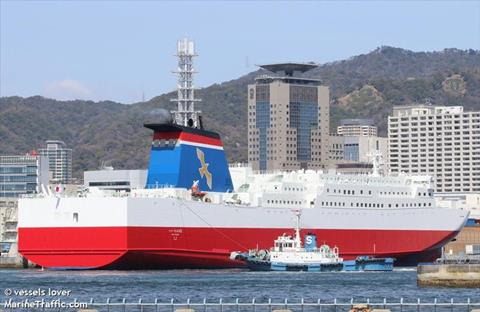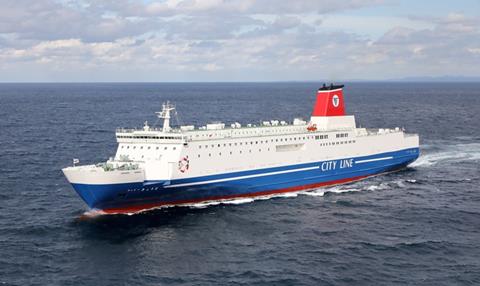Although continual renewal of the fleet is a longstanding characteristic of the Japanese coastal ferry sector, the accelerated investment drive of recent years is an expression of the national bid to foster a modal shift in domestic transport.
This provides a viable and more environmentally-beneficial alternative to long-distance trucking, and has been given greater emphasis not only by increasing road congestion but also by a shortage of truck drivers and no likelihood of such problems being resolved in the foreseeable future.
“Pielstick medium-speed power has been retained for the Naikai-built Ferry Takachiho.” “/ / 
Source: vessels
Pielstick medium-speed power has been retained for the Naikai-built Ferry Takachiho.
Moreover, rising interest among the population in using ferries not simply for necessary travel purposes but as a leisure activity in its own right is stimulating passenger traffic in certain areas and in turn leading to an elevation of onboard standards above the traditionally utilitarian levels that long pertained.
The industrial significance of the sustained, and recently increased, flow of newbuild work is the wholesale execution of construction contracts at domestic yards. At a time when China’s shipbuilding sector has come to dominate the international market for ro-pax and ro-ro ferries, the buoyancy in the Japanese ferry sector has ensured that Japanese shipbuilding has maintained a stake in a field that generates higher-value, often bespoke, design, production, engineering and outfitting work and which stimulates technological development.
Mitsubishi-built tonnage has this year revitalised one of the busiest overnight routes stretching the full length of the Seto Inland Sea. The 195m ro-pax sisters Ferry Kyoto and Ferry Fukuoka entered service between metropolitan Osaka and Kitakyushu (Shinmoji) on the western island of Kyushu, boosting sailing capacity and markedly improving efficiency and environmental impact compared to the operation with their 20 year-old predecessors.
Ordered to the joint account of Japan Railway Construction, Transport & Technology Agency (JRTT) and the Mitsui OSK Lines (MOL) subsidiary Meimon Taiyo Ferry Co, the new vessels are run by the latter under its City Line brand. The higher payload capability relative to the previous ships amounts to a freight intake corresponding to 162 trucks of the 12m Japanese size on two decks, plus 140 cars on separate, dedicated decks, together with 675 passengers.
The City Line entrants keep faith with the Pielstick medium-speed marque. Each shipset of two 12PC2.6B engines renders a combined output of 18,000kW, transmitted through a /single-output reduction gearbox to a single, controllable pitch propeller for a service speed of 23 knots. The powerful trunk engines were manufactured under licence from MAN Energy Solutions by JFE Engineering Corporation.
As innovatively employed in City Line’s preceding ro-pax generation, Ferry Kyoto and Ferry Fukuoka have a pair of azimuthing thrusters, one on each side of the stern, augmenting propulsive force exerted by the single main propeller, enhancing course stability and increasing manoeuvrability. The azimuthing propulsion-assist concept adds to the efficiency gains realised through the adoption of Mitsubishi’s under-hull air lubrication technology.
The Ferry Kyoto type also opens a new chapter in Japanese coastal ferry development by incorporating two-tier ro-ro access, using a new, double-level linkspan at Shinmoji.
“A product of Mitsubishi’s Shimonoseki yard, Ferry Kyoto nightly sails the full length of the Inland Sea” “/ / 
A product of Mitsubishi’s Shimonoseki yard, Ferry Kyoto nightly sails the full length of the Inland Sea
The ships are close in size to the limit set by the slipway at Mitsubishi’s Shimonoseki works, located at the westernmost end of Honshu on the Kanmon Strait. The yard is a prolific producer of large Japanese ferries, and it is once again showing its mettle with a seminal contract involving the construction of two 199m ro-pax vessels for the Ferry Sunflower arm of the MOL Group. Sunflower Kurenai and Sunflower Murasaki will rank as Japan’s first LNG-fuelled ferries, and are due to be commissioned in 2023 on the /Beppu (northern Kyushu) route.
Main machinery selection for the newbuilds not only provides a further reference in the Japanese market for Wartsila, but is also further endorses the Finnish company’s 31-series platform, widely considered to have raised the bar in medium-speed marine engine performance and fuel efficiency. Each vessel is equipped with two engines in the 31DF dual-fuel version, providing the power to ensure schedule-keeping carrying 763 passengers, 136 trucks and 100 cars at speeds up to 22.5 knots.
Four 14V31 diesel engines were supplied to each of the SHK Group’s two 2021 ro-pax deliveries from Mitsubishi’s Tategami works at Nagasaki, while two such diesels apiece power two 2020 completions by the Shimonoseki yard for Hankyu Ferry.
Naikai Zosen is an established name in the field of small and medium-size ferries, and is steadily making inroads into the market for the larger types of coastal ferry. The company’s rising profile has been brought into sharp relief this year, through recent deliveries and a production programme augmented by an order for two 199m, LNG-fuelled ferries. Constituting further investment by MOL in its Ferry Sunflower business and network, the ships will serve one of the longest routes, the northern connection between Tomakomai, on Hokkaido, and Oarai, north of the Tokyo metropolis. Deliveries from the Setoda (Innoshima) yard are planned for 2025.
The vessels’ primary role will be as freight carriers, with capacity for some 155 trucks, moving fresh produce southbound from Hokkaido to the densely populated /Yokohama region and returning with multifarious goods, while a modest 157-passenger capacity is expected to be used mainly by lorry drivers and business travellers.
Rather than taking the conventional approach in opting for powerful medium-speed machinery, MOL has specified a single, two-stroke dual-fuel engine for each vessel, the choice having fallen to an ME-GI series model from the MAN range. As well as virtually eliminating SOx emissions, the regular usage of LNG will contribute 25% to the vessels’ overall 35% reduction in CO₂release compared to the existing mainstays of the service.
Other efficiency-promoting measures will include a streamlined shape featuring an aerodynamically-rounded bow form, and a rectangular device known as the spray tearing plate (STEP) attached on both port and starboard sides of the upper bow to reduce wave-induced resistance. Tests have indicated that vessels equipped with STEP achieve a fuel efficiency gain of about 2% under actual operating conditions.
The Naikai pair will replace two 25-knot vessels delivered from Shimonoseki in 2001 by Mitsubishi, and equipped with twin Pielstick 12PC4-2V power.
This year’s output from Naikai’s Setoda yard is also illustrative of the company’s push into the long-haul ferry construction domain. Introduced to Miyazaki Car Ferry’s overnight route between Kobe and Miyazaki, on the southern coast of Kyushu, the 194m Ferry Takachiho encapsulates important design advances relative to the previous ro-pax generation, better ensuring long-term economic viability under rapidly evolving market and regulatory conditions. Ferry Takachiho and soon-to-be-delivered sister Ferry Rokko were ordered from Naikai Zosen to supersede two 170m vessels built in /1997.
Whereas the older ships were fitted with two Pielstick main engines of a combined 29,000kW output, the latest tonnage has been optimised to maintain the schedule using twin Pielstick propulsion yielding just 17,140kW. The 40% reduction in power, on top of the gains achieved in main engine technology and performance over the intervening period, translates into a radical lowering of fuel consumption. This has proved a timely investment, given the current and forecast trajectories for bunker prices.
For the earlier ferries, Miyazaki Express and Osaka Express, the primary power installation comprised two Pielstick 12PC4-2V engines, giving a total 29,125kW, and rendering a 25-knot service capability. The incoming Ferry Takachiho class, by contrast, has been specified with a pair of smaller Pielstick medium-speed diesels, whereby 12PC2-6B models producing 8,570kW at 600rpm deliver a combined 17,140kW. Drive is via reduction gearboxes to twin controllable pitch propellers turning at a maximum 134.6rpm. The arrangements demonstrate the shipbuilder’s prowess in formulating a hull design sized and faired for optimum efficiency, achieving a low block coefficient and satisfying the owner’s requirement for a service speed just in excess of 23 knots.
At a time when Wartsila is making inroads into the sector, Miyazaki’s project reaffirms trust in the Pielstick line which previously dominated the Japanese long-distance ferry market.
Ferry Takachiho has two freight decks for a maximum of 163 trucks or units of 12m, plus two lower levels specifically for up to 81 cars. Such is the level of customisation to the assigned service that the ro-ro access is offset rather than axial, by way of bow and stern quarter ramps on the port side at the main deck threshold.
Manoeuvring is facilitated by two bow tunnel thrusters and, instead of stern thrusters, by two reaction-type Schilling rudders.
Naikai is also undertaking Jumbo Ferry’s first newbuild contract in more than 30 years. The 132m ro-pax Aoi is being readied at Setoda for introduction to the /Takamatsu route on the eastern section of the Inland Sea. Equipped with a small-bore, two-stroke MAN diesel of 6,600kW, the new vessel is significantly more energy-efficient than her predecessor, and will thereby better ensure the future viability of a service that provides a competitive alternative to road transport between Shikoku and metropolitan Kobe.
Aoi offers a significantly greater freight capacity of 1,100 lane-metres in relation to the previous generation, and is suited to flows of trailer-borne containers and other cargo connecting with deep-sea shipping at Kobe. The direct-drive propulsion system is based on an eight-cylinder model of the S35ME-C9.7 engine, promising a service speed of about 18.5 knots.
Two-stroke, low-speed machinery is also central to A-Line Ferry Company’s ro-ro newbuild entrusted to Naikai. Sent down the ways on July 28, the 191m Ryukyu Express 7 is a multi-deck ro-ro equipped to carry trailers, chassis, trucks and passenger cars, and specified with a nine-cylinder model of the MAN S50ME-C8.5 engine rated at 15,930kW.
The unerring pursuit of cost efficiencies, higher standards, and technical measures that build resilience to intensifying environmental pressures, reflects in Japanese ferry design and buoyant production.





